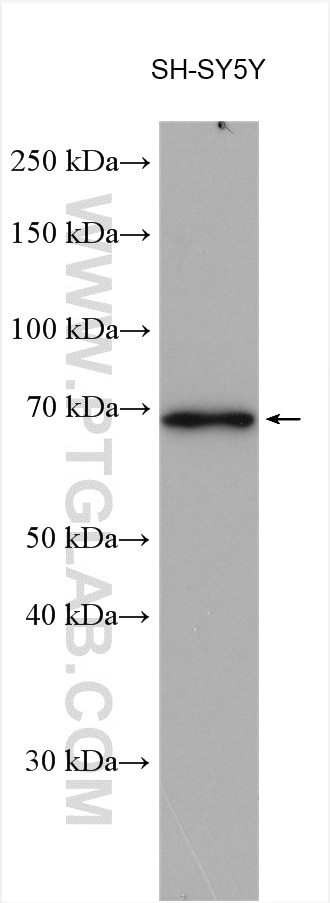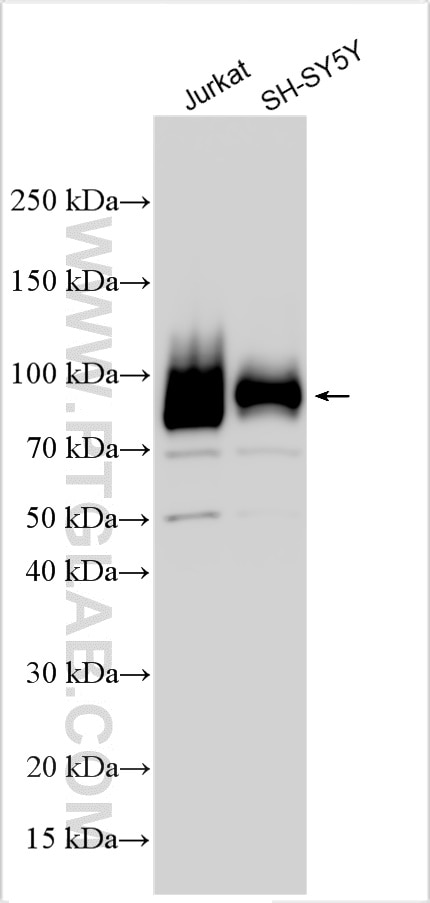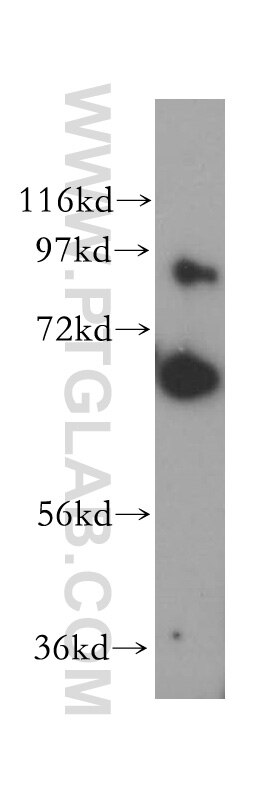- Featured Product
- KD/KO Validated
CEP68 Polyklonaler Antikörper
CEP68 Polyklonal Antikörper für WB, ELISA
Wirt / Isotyp
Kaninchen / IgG
Getestete Reaktivität
human
Anwendung
WB, IF, ELISA
Konjugation
Unkonjugiert
Kat-Nr. : 15147-1-AP
Synonyme
Geprüfte Anwendungen
| Erfolgreiche Detektion in WB | SH-SY5Y-Zellen, HeLa-Zellen, Jurkat-Zellen |
Empfohlene Verdünnung
| Anwendung | Verdünnung |
|---|---|
| Western Blot (WB) | WB : 1:1000-1:4000 |
| It is recommended that this reagent should be titrated in each testing system to obtain optimal results. | |
| Sample-dependent, check data in validation data gallery | |
Veröffentlichte Anwendungen
| KD/KO | See 4 publications below |
| WB | See 6 publications below |
| IF | See 6 publications below |
Produktinformation
15147-1-AP bindet in WB, IF, ELISA CEP68 und zeigt Reaktivität mit human
| Getestete Reaktivität | human |
| In Publikationen genannte Reaktivität | human |
| Wirt / Isotyp | Kaninchen / IgG |
| Klonalität | Polyklonal |
| Typ | Antikörper |
| Immunogen | CEP68 fusion protein Ag7447 |
| Vollständiger Name | centrosomal protein 68kDa |
| Berechnetes Molekulargewicht | 81 kDa |
| Beobachtetes Molekulargewicht | 90 kDa, 67 kDa |
| GenBank-Zugangsnummer | BC002982 |
| Gene symbol | CEP68 |
| Gene ID (NCBI) | 23177 |
| Konjugation | Unkonjugiert |
| Form | Liquid |
| Reinigungsmethode | Antigen-Affinitätsreinigung |
| Lagerungspuffer | PBS with 0.02% sodium azide and 50% glycerol |
| Lagerungsbedingungen | Bei -20°C lagern. Nach dem Versand ein Jahr lang stabil Aliquotieren ist bei -20oC Lagerung nicht notwendig. 20ul Größen enthalten 0,1% BSA. |
Hintergrundinformationen
CEP68, or centrosomal protein 68, is a protein-coding gene in humans. It is involved in the maintenance of centrosome cohesion, likely as part of a linker structure that prevents centrosome splitting. CEP68 is also required for the localization of CDK5RAP2 to the centrosome during interphase and contributes to the formation of CROCC/rootletin filaments. This protein is encoded by the CEP68 gene and is located on the fibers emanating from the proximal ends of centrioles. It has been associated with diseases such as Retinitis Pigmentosa 28 and is implicated in angioedema. The gene is mapped to chromosome 2 and is expressed ubiquitously in various tissues, including the brain, ovary, and others. The protein plays a crucial role in cellular functions related to the centrosome, which is a key organelle in cell division and organization. This antibody recognized two bands of ∼90 and 67 kDa, respectively, in good agreement with the predicted sizes of the two Cep68 isoforms (81 and 67 kDa for Cep68L and -S, respectively).
Protokolle
| PRODUKTSPEZIFISCHE PROTOKOLLE | |
|---|---|
| WB protocol for CEP68 antibody 15147-1-AP | Protokoll herunterladen |
| STANDARD-PROTOKOLLE | |
|---|---|
| Klicken Sie hier, um unsere Standardprotokolle anzuzeigen |
Publikationen
| Species | Application | Title |
|---|---|---|
J Virol The Cytoskeletal Adaptor Obscurin-Like 1 Interacts with the Human Papillomavirus 16 (HPV16) Capsid Protein L2 and Is Required for HPV16 Endocytosis.
| ||
Sci Rep Prolonged overexpression of PLK4 leads to formation of centriole rosette clusters that are connected via canonical centrosome linker proteins | ||
iScience Pathogenic LRRK2 regulates centrosome cohesion via Rab10/RILPL1-mediated CDK5RAP2 displacement. |




